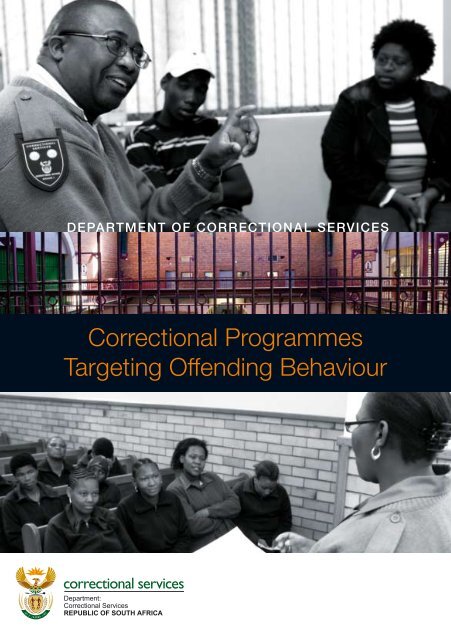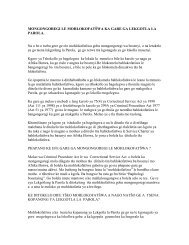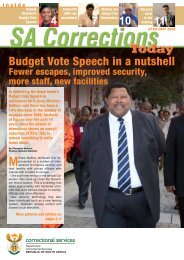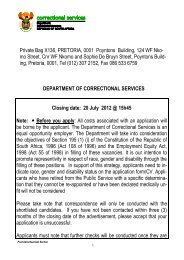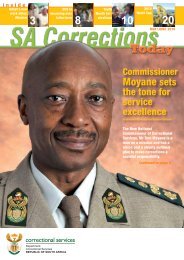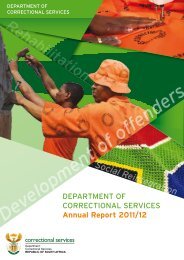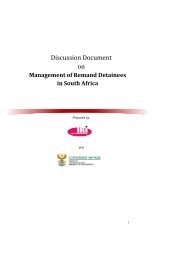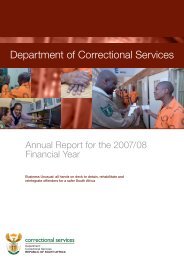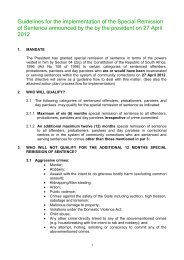Correctional Programmes Targeting Offending Behaviour
Correctional Programmes Targeting Offending Behaviour
Correctional Programmes Targeting Offending Behaviour
Create successful ePaper yourself
Turn your PDF publications into a flip-book with our unique Google optimized e-Paper software.
DEPARTMENT OF CORRECTIONAL SERVICES<br />
<strong>Correctional</strong> <strong>Programmes</strong><br />
<strong>Targeting</strong> <strong>Offending</strong> <strong>Behaviour</strong>
Table of Contents<br />
Executive summary 6<br />
1 Background 6<br />
2 Mandates 7<br />
2.1 The White Paper on Corrections in South Africa, 2005 7<br />
2.2 The <strong>Correctional</strong> Services Act, 1998<br />
(Act no. 111 of 1998) 7<br />
3 What are correctional programmes? 8<br />
3.1 Anger Management Programme 8<br />
3.1.1 Objective 8<br />
3.1.2 Target group 9<br />
3.1.3 Goals 9<br />
3.1.4 Outcomes 9<br />
3.1.5 Structure of the programme 9<br />
3.1.6 Programme material 10<br />
3.2 Crossroads <strong>Correctional</strong> Programme 10<br />
3.2.1 Objective 10<br />
3.2.2 Target group 10<br />
3.2.3 Goals 10<br />
3.2.4 Outcomes 11<br />
3.2.5 Structure of the programme 11<br />
3.2.6 Programme material 12<br />
3.3 Preparatory Programme on Sexual Offences 12<br />
3.3.1 Objective 12<br />
3.3.2 Target group 12<br />
3.3.3 Goals 12<br />
3.3.4 Outcomes 13<br />
3.3.5 Structure of the programme 13<br />
3.3.6 Programme material 14<br />
3.4 Pre-release Programme 14<br />
3.4.1 Objective 14<br />
3.4.2 Target group 14<br />
3.4.3 Goals 14<br />
3.4.4 Outcomes 14<br />
<strong>Correctional</strong> <strong>Programmes</strong>
3.4.5 Structure of the programme 15<br />
3.4.6 Programme material 15<br />
3.5 Substance Abuse <strong>Correctional</strong> Programme 15<br />
3.5.1 Objective 15<br />
3.5.2 Target group 15<br />
3.5.3 Goals 15<br />
3.5.4 Outcomes 16<br />
3.5.5 Structure of the programme 16<br />
3.5.6 Programme material 16<br />
3.6 Restorative Justice Orientation Programme 16<br />
3.6.1 Objective 16<br />
3.6.2 Target group 16<br />
3.6.3 Goals 17<br />
3.6.4 Outcomes 17<br />
3.6.5 Structure of the programme 17<br />
3.6.6 Programme material 18<br />
3.7 New Beginnings Orientation Programme 18<br />
3.7.1 Objective 18<br />
3.7.2 Target group 18<br />
3.7.3 Goals 18<br />
3.7.4 Outcomes 18<br />
3.7.5 Structure of the programme 19<br />
3.7.6 Programme material 19<br />
4 Standardization of correctional programmes 19<br />
4.1 Development of correctional programmes 19<br />
4.2 Phases of correctional programmes 19<br />
4.3 Programme intensity 20<br />
5 Mode of presentation and methodology 22<br />
5.1 Presentation by <strong>Correctional</strong> Intervention Official 22<br />
5.2 Presentation by offender or peer-educator 23<br />
6 Monitoring and evaluation 23<br />
7 Quality Assurance Committees 24
8 Implementation of <strong>Correctional</strong> <strong>Programmes</strong> 25<br />
8.1 Presentation of correctional programmes by officials 25<br />
8.2 Presentation of correctional programmes by offenders 25<br />
8.3 Training of programme implementers 26<br />
8.3.1 <strong>Correctional</strong> Intervention Officials 26<br />
8.3.2 Offenders 26<br />
8.4 Facilitation 26<br />
8.4.1 <strong>Correctional</strong> Intervention Officials 26<br />
8.4.2 Offenders 27<br />
8.5 Presentation of correctional programmes 27<br />
8.5.1 <strong>Correctional</strong> Intervention Officials 27<br />
8.5.2 Offenders (Peer Educators) 27<br />
8.5.3 External service providers 27<br />
8.6 Roles and responsibilities 27<br />
8.6.1 <strong>Correctional</strong> Intervention Officials 27<br />
8.6.2 Offenders 28<br />
8.6.3 External service providers 28<br />
8.7 Competencies 29<br />
8.7.1 <strong>Correctional</strong> Intervention Officials 29<br />
8.7.2 Peer educators 29<br />
9 Monitoring and evaluation 30<br />
9.1 The role of the Case Review Team (CRT) 30<br />
10 Benchmarking 30<br />
11 Monitoring and evaluation methods 30<br />
11.1 <strong>Correctional</strong> <strong>Programmes</strong> 30<br />
11.2 Programme Implementers 31<br />
11.3 Reporting 31<br />
12 Revision of existing programmes 32<br />
13 Conclusion 32<br />
References 34<br />
<strong>Correctional</strong> <strong>Programmes</strong>
Executive Summary<br />
The <strong>Correctional</strong> <strong>Programmes</strong> are just one of a number of endeavours<br />
which the Department of <strong>Correctional</strong> Services has embarked upon in<br />
its quest to rehabilitate offenders and reintegrate them into communities<br />
as law-abiding citizens. The aim is to join forces with stakeholders<br />
and civil society in pursuance of the common goal of inducing and<br />
supporting some type of change in the people who are participating<br />
in the programmes. The desired changes may include behavioural<br />
changes, acceptance of positive values and morals, increased<br />
knowledge, the acquisition of skills and improved mental and physical<br />
health.<br />
The timing, duration, focus and intensity of services shall be based<br />
on the assessment of an offender’s level of risk, needs, responsiveness,<br />
treatability, motivation and other relevant factors. Participation<br />
in services provided shall be based on a <strong>Correctional</strong> Sentence Plan<br />
(CSP) subject to informed consent. The Department of <strong>Correctional</strong><br />
Services believes that the responsibility to learn rests with the individual.<br />
Offenders must accept responsibility for their offences in order to<br />
gain insight into and understanding of their deviant and dysfunctional<br />
behaviour. Offenders should accept full accountability for their own<br />
behaviour throughout participation in the programmes.<br />
According to Inkanyezi Initiatives (2007, p12), the focus of rehabilitation<br />
and effective reintegration of offenders should be more on<br />
influencing behaviour and ultimately on facilitating individual behaviour<br />
change. <strong>Correctional</strong> programmes shall focus on raising awareness of<br />
the need to change behaviour and therefore reducing the likelihood of<br />
re-offending. Service providers and multidisciplinary team members<br />
shall be qualified and trained in accordance with their duties to ensure<br />
effective implementation of programmes.<br />
1. Background<br />
The responsibility of the Department of <strong>Correctional</strong> Services is first<br />
and foremost to correct offending behaviour in a secure, safe and humane<br />
environment in order to facilitate the rehabilitation process. Research,<br />
design and development of correctional programmes aimed<br />
at correcting offending behaviour are the functions of the Directorate<br />
of <strong>Correctional</strong> <strong>Programmes</strong>. The Directorate is also responsible for<br />
the development of a <strong>Correctional</strong> Sentence Plan (CSP), which has to
indicate all the interventions (services and programmes) that offenders<br />
need to be involved in, throughout their incarceration. The CSP<br />
should be based on the offenders’ assessed risks and needs.<br />
2. Mandates<br />
The Department operates in accordance with, inter alia, the following<br />
mandates:<br />
The White Paper on Corrections in South Africa, 2005<br />
The <strong>Correctional</strong> Services Act, 1998 (Act no. 111 of 1998)<br />
2.1 The White Paper on Corrections in South Africa, 2005<br />
Chapter 3 discusses corrections as a societal responsibility and the<br />
following sections are highlighted:<br />
• Section 3.3.5 provides for cooperative governance in contributing<br />
to the betterment of circumstances of families and communities.<br />
• Section 3.3.7 provides for the creation of an environment in which<br />
offenders are encouraged to discard negative and destructive<br />
values and replace them with positive and constructive values.<br />
Chapter 4 discusses the objectives of the South African <strong>Correctional</strong><br />
System and the following sections are relevant to this discussion:<br />
• Section 4.2.3 maintains that rehabilitation is achieved through<br />
delivery of key services to offenders, one of which is correction of<br />
the offending behaviour.<br />
• Section 4.2.4 maintains that rehabilitation is best facilitated<br />
through a holistic correctional sentence planning process that<br />
engages the offender at all levels of functioning, including social,<br />
moral, spiritual and physical levels.<br />
• Section 4.3.2 maintains that rehabilitation is the mission of departmental<br />
activities in partnership with external service providers.<br />
2.2 The <strong>Correctional</strong> Services Act, 1998 (Act no. 111 of 1998)<br />
Chapter 4 Section 41 of the Act provides for treatment, development<br />
and support services as follows:<br />
1. The Department must provide or give access to as full a range of<br />
programmes and activities as it is practicable to meet the educational<br />
and training needs of sentenced prisoners.<br />
2.<br />
Sentenced offenders who are illiterate or children may be com-<br />
<strong>Correctional</strong> <strong>Programmes</strong>
3.<br />
4.<br />
5.<br />
6.<br />
7.<br />
pelled to take part in the educational programmes offered in<br />
terms of subsection (1).<br />
The Department must provide social and psychological services<br />
in order to develop and support sentenced offenders by promoting<br />
their social functioning and mental health.<br />
Where practically possible, the Department must provide other<br />
development and support programmes, which meet the specific<br />
needs of sentenced offenders.<br />
Sentenced offenders have the right to take part in the programmes<br />
and use the services offered in terms of subsection (1),<br />
(3) and (4).<br />
Sentenced offenders may be compelled to participate in programmes<br />
and to utilize services offered in terms of subsection<br />
(1), (3) and (4) where, in the opinion of the Commissioner, their<br />
participation is necessary, based on the nature of their previous<br />
criminal conduct and the risk they pose to the community.<br />
<strong>Programmes</strong> must be responsive to special needs of women and<br />
they must ensure that women are not disadvantaged.<br />
3. What are <strong>Correctional</strong> <strong>Programmes</strong>?<br />
<strong>Correctional</strong> programmes are need-based programmes that address<br />
offending behaviour. It is compulsory for all sentenced offenders<br />
serving a sentence of 24 months and longer to attend correctional<br />
programme sessions. The Department of <strong>Correctional</strong> Services has<br />
developed and sourced seven correctional programmes, viz<br />
•<br />
•<br />
•<br />
•<br />
•<br />
•<br />
•<br />
Anger Management Programme<br />
Crossroads <strong>Correctional</strong> Programme<br />
Preparatory Programme on Sexual Offences<br />
Pre-release Programme<br />
Substance Abuse <strong>Correctional</strong> Programme<br />
Restorative Justice Orientation Programme<br />
New Beginnings Orientation Programme<br />
The programmes have been simplified so they can be presented by<br />
correctional officials who have been trained to implement correctional<br />
programmes.<br />
3.1 Anger Management Programme<br />
3.1.1 Objective<br />
This programme is aimed at raising offenders’ awareness of the<br />
causes and symptoms of anger and teaching them how to manage
their anger. It also helps offenders to unlearn old habits associated<br />
with aggression and learn or relearn healthy<br />
ways of dealing with and expressing anger.<br />
3.1.2 Target group<br />
The Anger Management correctional programme<br />
is aimed at all sentenced offenders<br />
who are serving sentences of 24 months<br />
and longer, based on the needs and risks<br />
identified in the individual offender’s correctional<br />
sentence plan.<br />
3.1.3 Goals<br />
The goals of the programme are to:<br />
• provide participants with information on the restoration of relationships<br />
• enable participants to compile and implement a personal anger<br />
coping plan to deal with and manage future anger response<br />
behaviour.<br />
3.1.4 Outcomes<br />
At the end of the programme the participant must have learned and<br />
be able to:<br />
•<br />
•<br />
•<br />
•<br />
understand what anger is and where it comes from<br />
control and manage feelings of anger in a socially acceptable<br />
manner<br />
understand and deal with feelings and behaviour linked to resentment,<br />
hostility, revenge and hatred<br />
compile and implement a personal anger coping plan to deal with<br />
and manage future anger response behaviour.<br />
3.1.5 Structure of the programme<br />
Programme sessions:<br />
Session 1: Introduction to anger in anger out programme<br />
Session 2: The facts about anger<br />
Session 3: Where does anger come from?<br />
Session 4: The results of anger: The anger inventory<br />
Session 5: Dealing with anger<br />
Session 6: Hatred and revenge<br />
Session 7: Restorative justice<br />
Session 8: Refusal skills – say no.<br />
Session 9: Coping plan – Stop, think and act.<br />
<strong>Correctional</strong> <strong>Programmes</strong>
10<br />
Session 10: Closure – Where do I go from here?<br />
3.1.6 Programme material<br />
The Anger Management correctional programme consists of a Facilitator’s<br />
Manual and a Workbook for participants.<br />
3.2 Crossroads <strong>Correctional</strong> Programme<br />
3.2.1 Objective<br />
The main purpose of the Crossroads <strong>Correctional</strong><br />
Programme is to target offending<br />
behaviour through the implementation of<br />
basic behaviour modification techniques.<br />
The programme focuses on the causes and<br />
consequences of the abuse of alcohol and<br />
drugs and of criminal behaviour. It seeks to<br />
provide offenders with information concerning<br />
alternatives to criminal behaviour and<br />
sources for treatment of alcoholism and<br />
drug dependence. It also provides offenders<br />
with information on sexually transmitted<br />
infections and sources of treatment for them.<br />
3.2.2 Target group<br />
The Crossroads <strong>Correctional</strong> Programme is aimed at all the sentenced<br />
offenders who are serving a sentence of 24 months and<br />
longer based on the needs and risks identified in the offender’s<br />
<strong>Correctional</strong> Sentence Plan. Ideally, the Crossroads <strong>Correctional</strong><br />
Programme should be presented to the identified offenders upon their<br />
admission to the system.<br />
3.2.3 Goals<br />
The goals of the programme are to:<br />
• equip case officers with the necessary skills to enable them to<br />
identify the need for social work, psychological, educational and<br />
spiritual or religious intervention and to refer offenders for such<br />
treatment<br />
• facilitate the implementation of the Unit Management System<br />
which is aimed at effecting change in the lives of the offenders<br />
who are entrusted to the care of the Department of <strong>Correctional</strong><br />
Services<br />
•<br />
fast-track one of the key strategies enshrined in the White Paper
•<br />
•<br />
on Corrections by allowing all correctional officials to be more<br />
directly involved in the rehabilitation of offenders<br />
bring about an effective balance in all the significant facets<br />
pertaining to offenders, including their safety and security, their<br />
rehabilitation, meaningful utilization of their time, their development<br />
and just treatment<br />
equip offenders with the necessary knowledge and skills to<br />
enable them to become responsible, law-abiding and productive<br />
citizens to order to ensure their successful reintegration into<br />
society.<br />
3.2.4 Outcomes<br />
To ensure that offenders have:<br />
• a good understanding of the crossroads programme<br />
• a better understanding of themselves, their strengths and weaknesses<br />
• an understanding of the impact of their choices and take responsibility<br />
for their choices<br />
• acquired the skills necessary to prevent and manage conflict<br />
• an understanding of the consequences of crime and criminal<br />
behaviour<br />
•<br />
a better understanding of the consequences of substance abuse.<br />
3.2.5 Structure of the programme<br />
Module 1: Orientation<br />
1.1 Orientation<br />
1.2 Who am I?<br />
Module 2: The crossroads<br />
Module 3: Criminal behaviour<br />
3.1 What is criminal behaviour?<br />
3.2 Causes of criminal behaviour<br />
3.3 Further causes of criminal behaviour<br />
3.4 Consequences of criminal behaviour<br />
3.5 Alternatives to criminal behaviour<br />
3.6 Advantages and disadvantages of criminal behaviour<br />
3.7 Positive behaviour<br />
Module 4: Alcohol abuse<br />
4.1 What is alcoholism?<br />
4.2 Phases of alcoholism<br />
<strong>Correctional</strong> <strong>Programmes</strong> 11
1<br />
4.3 Causes and consequences of alcoholism<br />
4.4 The influence of alcoholism<br />
4.5 Possibilities of treatment<br />
Module 5: Drug abuse<br />
5.1 Habit-forming drugs<br />
5.2 Causes of drug abuse<br />
5.3 Consequences of drug abuse<br />
5.4 Sources for treatment<br />
Module 6: Sexually transmitted infections<br />
6.1 Sexually transmitted diseases<br />
6.2 AIDS<br />
6.3 Safe sexual practices<br />
3.2.6 Programme material<br />
The Crossroads <strong>Correctional</strong> Programme consists of a facilitator’s<br />
manual and a participant’s workbook.<br />
3.3 Preparatory Programme on Sexual<br />
Offences<br />
3.3.1 Objective<br />
The main objective of the Preparatory<br />
Programme on Sexual Offences is to<br />
involve sexual offenders in a correctional<br />
programme addressing their sexual offending<br />
behaviour through the acquisition<br />
of the relevant knowledge and skills.<br />
3.3.2 Target group<br />
The Preparatory Programme on Sexual Offences is aimed at targeting<br />
all sentenced offenders who are serving a sentence of 24 months and<br />
longer based on the needs and risks identified in the offender’s <strong>Correctional</strong><br />
Sentence Plan.<br />
3.3.3 Goals<br />
The goals of the programme are to:<br />
• assist offenders to identity the possible causes of their deviant<br />
sexual behaviour<br />
•<br />
change the offender’s negative behaviour and to prevent further<br />
sexual offences
•<br />
•<br />
•<br />
•<br />
•<br />
•<br />
empower offenders with information on the biological development<br />
of human beings and the phases of the sexual response<br />
cycle<br />
broaden offenders’ knowledge of the legal implications of sexual<br />
offences<br />
ensure that offenders understand the identity and roles of males<br />
versus females and to sensitize offenders to the issue of sexual<br />
harassment<br />
assist offenders in the identification of possible precursors to<br />
sexual offending and to provide them with strategies to cope with<br />
these triggers<br />
assist offenders to take responsibility for their offending behaviour<br />
by focusing on the consequences of crime as well as the restoration<br />
of relationships through Restorative Justice<br />
empower offenders to resist re-offending by teaching them to<br />
reflect on their offending behaviour and to compile a coping plan<br />
for the future by identifying goals for their future and preparing<br />
them for possible setbacks that may occur.<br />
3.3.4 Outcomes<br />
Offenders are:<br />
• provided with information on the phases of human development<br />
• empowered by learning to understand and control their needs<br />
and gain insight into the sexual response cycle<br />
• equipped with an understanding of sexuality and related concepts<br />
within the context of cultural differences<br />
• provided with problem-solving skills, coping strategies and the<br />
ability to identify triggers to their sexual offending behaviour<br />
• provided with knowledge of the physical, emotional and financial<br />
consequences of crime<br />
•<br />
given the tools to prevent relapse.<br />
3.3.5 Structure of the programme<br />
Programme sessions:<br />
Session 1: Introduction and orientation<br />
Session 2: Possible causes of sexual offending<br />
Session 3: Development of human beings: phases and the sexual<br />
response cycle<br />
Session 4: Relevant definitions and legal implications<br />
Session 5: Roles and identity: male versus female<br />
Session 6: Immediate precursors to sexual offending and possible<br />
coping strategies<br />
<strong>Correctional</strong> <strong>Programmes</strong> 1
1<br />
Session 7: Consequences of crime<br />
Session 8: Introduction to restorative justice<br />
Session 9: Relapse prevention<br />
3.3.6 Programme material<br />
The Preparatory Programme on Sexual Offences comprises of a<br />
facilitator’s manual and a participant’s workbook.<br />
3.4 Pre-release Programme<br />
3.4.1 Objective<br />
The objective of the Pre-release Programme is to<br />
prepare offenders for successful reintegration into<br />
society by providing them with skills and information<br />
to enable them to cope with possible challenges<br />
they may have to face after their release.<br />
3.4.2 Target group<br />
All sentenced offenders who have release dates<br />
are obliged to have completed this programme before release from<br />
the correctional centre.<br />
3.4.3 Goals<br />
The goals of the programme are to:<br />
• prepare offenders for successful reintegration into society<br />
• provide offenders with the skills necessary to overcome difficulties<br />
associated with reintegration<br />
• prevent re-offending and relapse<br />
• ensure that proper support systems are in place before placement<br />
• provide information on external resources<br />
• restore relationships<br />
• teach offenders to take responsibility for their own behaviour<br />
• build self-esteem and self-confidence.<br />
3.4.4 Outcomes<br />
To ensure that:<br />
• the offender understands the aims and objectives of the pre-release<br />
programme<br />
• offenders realize their responsibility to themselves, their families,<br />
their communities and to provide for their own futures<br />
•<br />
offenders are able to compile and implement a personal coping
•<br />
•<br />
•<br />
•<br />
plan to deal with and manage future challenges<br />
successful social reintegration takes place<br />
offenders can establish support systems and meaningful relationships<br />
recidivism is reduced<br />
offenders are provided with the necessary skills and after-care to<br />
enable them to adapt.<br />
3.4.5 Structure of the programme<br />
Programme sessions:<br />
Session 1: Introduction and orientation<br />
Session 2: Health education<br />
Session 3: Financial management<br />
Session 4: Relationships<br />
Session 5: Restorative justice<br />
Session 6: Finding employment<br />
Session 7: Parole conditions<br />
Session 8: Substance abuse: relapse prevention<br />
Session 9: Closure/Evaluation<br />
3.4.6 Programme material<br />
The Pre-release Programme comprises of a facilitator’s manual.<br />
3.5 Substance Abuse <strong>Correctional</strong> Programme<br />
3.5.1 Objective<br />
The main purpose of the Substance Abuse<br />
programme is to help participants gain insight<br />
into the negative effects of substance abuse.<br />
3.5.2 Target group<br />
The Substance Abuse programme is aimed<br />
at targeting all sentenced offenders who are<br />
serving a sentence of 24 months and longer,<br />
based on the needs and risks identified in the<br />
offender’s <strong>Correctional</strong> Sentence Plan.<br />
3.5.3 Goals<br />
The goals of the programme are to:<br />
• help offenders overcome alcohol and drug addiction<br />
•<br />
empower participants with information related to substance<br />
abuse and the addiction process<br />
<strong>Correctional</strong> <strong>Programmes</strong> 1
1<br />
•<br />
•<br />
•<br />
•<br />
educate participants on the signs and symptoms of substance<br />
addiction<br />
enable participants to have a better understanding of themselves<br />
empower participants with coping skills<br />
provide participants with information on how to restore broken<br />
relationships.<br />
3.5.4 Outcomes<br />
To ensure that offenders are equipped with:<br />
• knowledge of the signs and symptoms of substance addiction<br />
• a better understanding of the self (offender)<br />
• information on how to restore broken relationships<br />
•<br />
coping skills in relation to substance abuse and the addiction<br />
process.<br />
3.5.5 Structure of the programme<br />
Programme sessions:<br />
Session 1: Introduction and overview of addictive substances<br />
Session 2: Cycle and costs of addiction<br />
Session 3: Causes and Symptoms of substance abuse<br />
Session 4: Addictive habits and how to deal with them<br />
Session 5: Dealing with addiction<br />
Session 6: Drug refusal techniques<br />
Session 7: Decision-making<br />
Session 8: Relapse prevention<br />
Session 9: Coping during recovery<br />
Session 10: Restoration of relationships<br />
3.5.6 Programme material<br />
The Substance Abuse correctional Programme comprises of a facilitator’s<br />
manual and a workbook for participants.<br />
3.6 Restorative Justice Orientation Programme<br />
3.6.1 Objective<br />
The main objective of this programme is to orientate offenders in respect<br />
of restorative justice and to prepare them for further intervention<br />
through restorative justice programmes.<br />
3.6.2 Target group<br />
This programme can be presented to sentenced offenders as well<br />
as probationers, after they have undergone programmes addressing
their offending behaviour. It could also be<br />
used for all special categories of offenders,<br />
guided by the needs and risks identified in<br />
their individual correctional sentence plan.<br />
3.6.3 Goals<br />
The goals of the programme are to:<br />
• empower offenders in respect of the<br />
basic concepts in restorative justice<br />
• orientate offenders regarding the various<br />
programmes in restorative justice<br />
• illustrate the relationship between restorative<br />
justice and rehabilitation<br />
• introduce the concept of victim empowerment<br />
• emphasize the importance of support systems<br />
• illustrate the link between restorative justice and reintegration.<br />
3.6.4 Outcomes<br />
At the end of the programme offenders are expected to have been<br />
provided with an understanding of the:<br />
•<br />
•<br />
•<br />
•<br />
•<br />
•<br />
•<br />
•<br />
basic concepts in restorative justice<br />
factors that lead to crime and how to deal with them<br />
importance of changing offending behavioural patterns<br />
concept of restorative justice in general and within the context of<br />
the Department of <strong>Correctional</strong> Services<br />
relationship between restorative justice, rehabilitation and reintegration<br />
various programmes of restorative justice and their benefits<br />
concept of and insight into victim empowerment<br />
roles of the different support systems.<br />
3.6.5 Structure of the programme<br />
Programme sessions:<br />
Session 1: ntroduction to the Restorative Justice Programme<br />
Session 2: Circumstances leading to crime<br />
Session 3: Restorative justice and rehabilitation<br />
Session 4: Different programmes in restorative justice<br />
Session 5: Victim empowerment in South Africa<br />
Session 6: Support systems<br />
Session 7: Reintegration<br />
Session 8: Closure<br />
<strong>Correctional</strong> <strong>Programmes</strong> 1
1<br />
3.6.6 Programme material<br />
The programme consists of a facilitator’s manual and a workbook for<br />
participants.<br />
3.7 New Beginnings Orientation Programme<br />
3.7.1 Objective<br />
The New Beginnings orientation programme<br />
is aimed at empowering offenders<br />
to be more aware of themselves and the<br />
situation around them. The programme<br />
also allows for offenders’ transition into<br />
and adjustment to the correctional centre.<br />
3.7.2 Target group<br />
All categories of offenders can benefit from the New Beginnings<br />
programme based on the needs, risks and level of responsiveness<br />
identified during assessment.<br />
3.7.3 Goals<br />
The goals are to:<br />
• empower offenders to be more aware of themselves and the situation<br />
around them<br />
• serve as an orientation correctional programme which will help<br />
offenders to adjust properly within correctional facilities by focusing<br />
on:<br />
• Self-esteem<br />
• Decision-Making<br />
• Gangsterism<br />
• Smuggling<br />
• Services available in the correctional centre<br />
3.7.4 Outcomes<br />
The outcomes are as follows:<br />
• a better understanding of the general overview of a correctional<br />
setting<br />
• self-control and adequate decision-making skills<br />
• the ability to identify one’s roles in life based on the principle of<br />
importance and not urgency<br />
• the ability to set goals for one’s life<br />
•<br />
discovering one’s role in decision-making and being able to apply<br />
decision-making skills
•<br />
•<br />
understanding and knowledge of how to cope in a correctional<br />
centre<br />
knowledge and understanding of the services rendered in a correctional<br />
centre.<br />
3.7.5 Structure of the programme<br />
Programme sessions:<br />
Session 1: Introduction and general orientation to the New Beginnings<br />
Orientation Programme<br />
Session 2: Human freedom: The power to choose, to respond and to<br />
change<br />
Session 3: Four needs of our lives<br />
Session 4: Myself and crime<br />
Session 5: Decision-making<br />
Session 6: How to cope in a correctional centre<br />
Session 7: Services rendered in a correctional centre<br />
Session 8: Closure<br />
3.7.6 Programme material<br />
The programme consists of a facilitator’s manual and a workbook for<br />
participants.<br />
4. Standardization of <strong>Correctional</strong> <strong>Programmes</strong><br />
4.1 Development of correctional programmes<br />
The development of correctional programmes should be based on<br />
the needs identification and analysis, literature review and analysis<br />
of current practices. The analysis should determine the programme<br />
design, that is, the structure and content. The profiles of offenders will<br />
also assist in developing the relevant correctional programmes for the<br />
relevant categories of offenders.<br />
<strong>Correctional</strong> programmes, monitoring and evaluation systems should<br />
be scientifically researched and informal research should be conducted<br />
through seminars, workshops and conferences.<br />
4.2 Phases of correctional programmes<br />
<strong>Correctional</strong> programmes have numerous points of contact and<br />
degrees of overlap with other types of interventions that have the essential<br />
aim of engendering individual change on the basis of personal<br />
<strong>Correctional</strong> <strong>Programmes</strong> 1
0<br />
choice (McGuire, J: 1995). This includes education that focuses on<br />
helping individuals acquire knowledge and information. It includes<br />
training, which is designed to help people acquire manual or cognitive<br />
skills for application in their lives. All of these processes involve new<br />
modes of thinking and problem solving that are transferable across<br />
situations, and instil new self perceptions.<br />
Phase 1: The Educational approach is didactic in nature. Participants<br />
will attend educational group sessions and will be required to do exercises<br />
on their own, which are designed to help them understand the<br />
content of each area. The focus should be on providing knowledge<br />
and information.<br />
Phase 2: This phase should reinforce the education training of the<br />
first phase and should assist the offender to emotionally connect the<br />
educational training with his or her own experiences and life. Offenders<br />
should be provided with opportunities to talk about their behaviour,<br />
to discover different ways to deal with a situation, and activities<br />
should be provided to them to practice new behaviours. This will help<br />
offenders strengthen their self-esteem and personal resources for<br />
reintegration into the community without re-offending.<br />
Phase 3: Monitoring and evaluation should be incorporated to assess<br />
where the person is at in the phases. Evaluation should focus on the<br />
person, the process and the product/outcome in order to determine<br />
the effectiveness of the programme. Monitoring and evaluation should<br />
be conducted at different levels of programme implementation, i.e.<br />
elementary, intermediate and advanced to determine efficacy.<br />
4.3 Programme intensity<br />
<strong>Correctional</strong> programmes are presented on a continuum as illustrated<br />
below, from low intensity levels such as elementary or basic to intermediate<br />
and advanced. Low intensity intervention targets the masses<br />
and high intensity intervention focuses more on individuals. The offender<br />
can access the programmes and services at different levels of<br />
the continuum depending on the needs.<br />
Basic or elementary and intermediate programmes should be rendered<br />
by correctional intervention officials whereas advanced programmes<br />
should be rendered by professionals such as social workers,<br />
psychologists etc. <strong>Correctional</strong> Intervention Officials should be
trained in the referral process, that is, how to identify the offender<br />
who needs advanced interventions. The intensity levels of correctional<br />
programmes are determined as follows:<br />
<strong>Correctional</strong> programmes<br />
Low High<br />
Basic Intermediate Advanced<br />
Elementary Interventions Interventions<br />
or<br />
<strong>Correctional</strong> programmes<br />
High Low<br />
Advanced Intermediate Basic/ Elementary<br />
Interventions Interventions Interventions<br />
(i) High intensity and advanced interventions<br />
High intensity programmes are recommended for offenders whose<br />
assessment has indicated a higher risk to re-offend.<br />
•<br />
•<br />
Programme delivery should be from 6-8 months<br />
<strong>Programmes</strong> should be closed with specific entry and completion<br />
dates.<br />
(ii) Moderate intensity and intermediate interventions<br />
Moderate intensity programmes are recommended for offenders<br />
whose assessment has indicated a moderate risk with need levels<br />
that are either moderate or high.<br />
•<br />
•<br />
Programme delivery should be from 4-5 months<br />
<strong>Programmes</strong> should be closed with specific entry and completion<br />
dates.<br />
(iii) Low intensity, basic and elementary interventions<br />
Low intensity programmes are recommended for low-risk offenders<br />
whose needs may range from low to moderate.<br />
•<br />
•<br />
Programme delivery should be from 2-4 months<br />
Programme may be open with continuous intake.<br />
<strong>Correctional</strong> <strong>Programmes</strong> 1
5. Mode of Presentation and Methodology<br />
Group work is an ideal method of intervention for targeting the<br />
masses. <strong>Correctional</strong> programmes will be conducted following this<br />
method. Group work as a method of intervention is essential in bringing<br />
people with a common purpose together. The size of the group<br />
should be linked to programme intensity. The lower the intensity of<br />
the programme is, the larger the group could be. Group sizes will<br />
normally fall between 10 and 20. Such groups can be presented on a<br />
continuum from low to high intensity levels as already stated above.<br />
5.1 Presentation by <strong>Correctional</strong> Intervention Official<br />
In order to comply with the stipulations of the <strong>Correctional</strong> Services<br />
Act, the White Paper on Corrections and the Strategic Plan of the Department,<br />
it was necessary to appoint full-time <strong>Correctional</strong> Intervention<br />
Officials (CIOs) who are required to facilitate correctional programmes<br />
aimed at addressing offence-specific offending behaviour.<br />
Methods used during the facilitation process are:<br />
Participatory: The official as a facilitator should ensure that all group<br />
members participate by going around the group and having each<br />
member taking a turn to share information. Skills and behaviour can<br />
also be demonstrated as a way of providing information to the group.<br />
Interactive: The facilitators should provide an environment where<br />
there is interactive communication e.g. by avoiding lecturing as a<br />
method of presentation. The facilitators should ensure that they understand<br />
the concept of group dynamics (processes which groups go<br />
through) and that they are able to mobilize such processes throughout<br />
the life-span of the group for the benefit of each group member.<br />
Experiential: The facilitators should implement experiential learning<br />
using the following functional aids:<br />
• role-playing and drama<br />
• play (use of games)<br />
• collage<br />
• talk (discussions such as debates on different topics of interest)<br />
• movement (exploration of touch, non-verbal communication,<br />
dance, music and physical encounter)<br />
•<br />
work (activities such as projects and tasks involving co-operative<br />
endeavour).
In and out sessions: The facilitators could give tasks for group participants<br />
to complete during group sessions or outside of the group.<br />
5.2 Presentation by offender as peer-educator<br />
Participative: The offender as a peer educator should ensure participation<br />
by all the group members by going around the group and<br />
having each member taking a turn in sharing information. The peer<br />
educator could also demonstrate skills and /or behaviour as a way of<br />
providing information to the group.<br />
Interactive: The peer educators should provide an environment<br />
where there is interactive communication e.g. by avoiding lecturing as<br />
a method of presentation. They should ensure that they understand<br />
the concept of group dynamics (processes which groups go through)<br />
and that they are able to mobilize such processes throughout the lifespan<br />
of the group for the benefit of each group member.<br />
Experiential: The offender should implement experiential learning<br />
through the use of some or all of the following aids:<br />
• role-playing and drama<br />
• play(use of games)<br />
• collage<br />
• talk (discussions such as debates on different topics of interest)<br />
• movement (exploration of touch, non-verbal communications,<br />
dance, music and physical encounter)<br />
•<br />
work (activities such as projects and tasks involving co-operative<br />
endeavour)<br />
In and out sessions: The peer educators could give group participants<br />
tasks to complete during or outside of group sessions.<br />
6. Monitoring and Evaluation<br />
Monitoring and evaluation tools should be integrated into every correctional<br />
programme, for example, attendance registers, evaluation<br />
forms, etc. A pre-assessment tool, specific to each programme,<br />
should be developed to determine offenders’ current level of knowledge,<br />
beliefs, understanding, insight, attitude, etc in order to identify<br />
specific needs.<br />
<strong>Correctional</strong> <strong>Programmes</strong>
The efficiency of programme facilitation should be monitored and<br />
evaluated by means of the submission of evaluation reports to the<br />
relevant delegated authorities.<br />
The evaluation of interventions will focus on the individual performance<br />
of CIOs and external service providers, and on the quality, efficiency<br />
and effectiveness of the programme.<br />
Outcome evaluations are useful for determining the effectiveness<br />
of established programmes, but cannot be used to evaluate new<br />
programmes. The only way to evaluate new programmes is through<br />
accreditation standards.<br />
7. Quality Assurance Committees<br />
The Department has established quality assurance committees at<br />
National, Regional and Management Area levels of the organizational<br />
structure.<br />
The main purpose of the Quality Assurance Committees is to quality<br />
assure, endorse and co-ordinate programmes that are going to be<br />
implemented for offenders in correctional centres. There are certain<br />
minimum standards that need to be met prior to endorsement. (Refer<br />
to the Quality Assurance Minimum Standards Manual). <strong>Programmes</strong><br />
that have been quality assured at management and regional level<br />
should be submitted to the National Office for consolidation and updating<br />
of the national database of available programmes.<br />
In order to maintain a standard of quality and relevance, correctional<br />
programmes shall be subjected to quality assurance processes and<br />
a programme will qualify as a correctional programme when it meets,<br />
inter alia, the criteria mentioned below. It must:<br />
•<br />
•<br />
•<br />
•<br />
•<br />
•<br />
•<br />
•<br />
qualify as a research based model of change<br />
have selection criteria<br />
indicate the targeted criminogenic factors<br />
have effective methods of delivery, including a statement of<br />
qualifications for <strong>Correctional</strong> Intervention Officials, programme<br />
facilitators and implementers<br />
have response from participant<br />
indicate the programme intensity level(s)<br />
indicate the frequency and the duration of the programme<br />
have the correct methodology of presentation
•<br />
•<br />
•<br />
have programme goals, objectives, outcomes and indicators<br />
have pre-programme assessment, and<br />
have built-in monitoring and evaluation tools.<br />
8. Implementation of <strong>Correctional</strong> <strong>Programmes</strong><br />
Implementation of correctional programmes is a challenging prospect.<br />
Training and dissemination is considered the great challenge facing<br />
implementation in the field of corrections. The assessment of the risks<br />
and needs of offenders will be undertaken by the Comprehensive<br />
Assessment Team (CAT), where after the offender’s <strong>Correctional</strong><br />
Sentence Plan (CSP) will be developed. The Chairperson of the Case<br />
Management Committee (CMC) will approve the developed <strong>Correctional</strong><br />
Sentence Plan (CSP). Offenders will then be allocated to the<br />
relevant housing units where the structured day programme will be<br />
implemented.<br />
Offenders will be assigned to a correctional programme based on<br />
their <strong>Correctional</strong> Sentence Plan (CSP). Case Officers must ensure<br />
that offenders attend correctional programmes, which are recommended<br />
in their CSP and <strong>Correctional</strong> Intervention Officials (CIOs)<br />
must present the programmes. All participation in correctional programmes<br />
must be based on informed consent. Pre-program assessments<br />
must be completed by the CIO or programme facilitator prior<br />
to implementation of correctional programmes and offenders must<br />
be encouraged to participate. Peer facilitators will not be expected to<br />
complete the pre-assessment tools.<br />
8.1 Presentation of correctional programmes by officials<br />
<strong>Correctional</strong> intervention officials (CIOs) will be utilized for programme<br />
implementation at low to moderate intensity. CIOs are to refer offenders<br />
requiring high-intensity intervention to professionals.<br />
Case officers are to deal with day-to-day activities and refer offenders<br />
to professionals when specific risks and needs have been identified.<br />
Professionals are to implement programmes at a high level of intensity.<br />
8.2 Presentation of correctional programmes by offenders<br />
Offenders who are trained as peer educators should be age and<br />
<strong>Correctional</strong> <strong>Programmes</strong>
gender sensitive, for example, a female offender cannot conduct programmes<br />
in a male correctional centre and a juvenile cannot conduct<br />
programmes in an adult facility.<br />
Language and literacy levels should be considered when selecting<br />
offenders for training as peer educators.<br />
8.3 Training of programme implementers<br />
CIOs will be trained in group work processes, facilitation skills, report<br />
writing, when to refer offenders, monitoring and evaluation, and the<br />
use of activity-based learning to meet learning styles of offenders.<br />
8.3.1. <strong>Correctional</strong> Intervention Officials<br />
The introductory course on Group Facilitation Skills could be incorporated<br />
into the basic training of correctional officials. <strong>Correctional</strong><br />
intervention officials will be responsible for:<br />
•<br />
•<br />
•<br />
•<br />
utilization of the Train-the-trainer Programme<br />
the empowerment of officials and trainees through continuous<br />
professional development<br />
the provision of ongoing in-service training, and<br />
role-modelling and mentoring through co-facilitation with external<br />
service providers and professionals.<br />
8.3.2 Offenders<br />
Offenders will be responsible for:<br />
• peer education training<br />
• role-modelling and mentoring through co-facilitation with the correctional<br />
intervention official and external service providers.<br />
Peer educators will only present informative sessions in respect of<br />
which they will not be expected to write process or progress reports<br />
on the offender.<br />
8.4 Facilitation<br />
8.4.1 <strong>Correctional</strong> Intervention Officials<br />
<strong>Correctional</strong> Intervention Officials will be responsible for:<br />
• co-facilitation with internal and external service providers leading<br />
to skills transfer<br />
• facilitation on an individual basis<br />
•<br />
collaboration with internal and external service providers.
8.4.2 Offenders<br />
Offenders will be responsible for:<br />
• peer education<br />
• co-facilitation with internal and external service providers.<br />
8.5 Presentation of correctional programmes<br />
The following role players will present <strong>Correctional</strong> <strong>Programmes</strong>:<br />
8.5.1. <strong>Correctional</strong> Intervention Officials (CIOs)<br />
These are officials with a Human or Social Sciences educational<br />
background who have been trained in programme implementation.<br />
Facilitators of correctional programmes will be selected and supported<br />
in a way that enhances their well-being and reduces any risk<br />
of potential negative psychological impacts resulting from the work.<br />
8.5.2. Offenders (peer educators)<br />
The offenders who will be trained as peer educators must have attended<br />
and successfully completed specific programmes themselves.<br />
They must also meet the set criteria. They must liaise with the relevant<br />
case officers and programme implementers/facilitators.<br />
8.5.3. External service providers<br />
External service providers will render quality assured programmes<br />
according to the offender’s risks and needs as identified in the <strong>Correctional</strong><br />
Sentence Plan (CSP).<br />
8.6 Roles and responsibilities<br />
8.6.1 <strong>Correctional</strong> Intervention Officials (CIO):<br />
<strong>Correctional</strong> Intervention Officials will be responsible for:<br />
• preparation for programme implementation<br />
• preparation of offenders for involvement in a specific programme,<br />
to determine their current level of knowledge, beliefs,<br />
understanding, insight, attitude, etc in order to identify specific<br />
needs (Each correctional programme will have a built-in pre-programme<br />
assessment form that should be completed by the CIO<br />
or programme implementer with the offender prior to the implementation<br />
of a specific programme. This will assist CIOs and<br />
programme implementers to determine the participants’ level of<br />
knowledge when evaluating them at the end of the programme)<br />
•<br />
facilitation and implementation of programmes<br />
<strong>Correctional</strong> <strong>Programmes</strong>
•<br />
•<br />
•<br />
•<br />
•<br />
•<br />
•<br />
•<br />
•<br />
role-modelling in group facilitation<br />
monitoring and evaluation of the processes and impact of the<br />
programme<br />
compilation of individual process notes according to the prescribed<br />
format<br />
compilation of individual progress reports at the end of the programme<br />
submission of monthly statistics to the Chairperson of the Case<br />
Management Committee and progress reports to the Case<br />
Officer for filing and to CIT representatives for presentation of offenders<br />
during Case Review Team sessions<br />
training and mentoring of peer educators in the conducting of<br />
group programmes<br />
performance of administrative tasks that are relevant to the job<br />
observation of the behaviour of individual group members and<br />
the identification of problems that warrant referral<br />
Supervision of peer educators.<br />
8.6.2 Offenders<br />
Offenders will be responsible for:<br />
• attending and successfully completing a specific programme<br />
before becoming peer educators<br />
• attending and completing training in peer education<br />
• preparation for programme implementation in collaboration with<br />
the co-facilitator/CIO<br />
• implementation of group programmes as peer educator<br />
• reporting to supervisor (CIO) on progress in terms of group processes<br />
and impact of the programme<br />
• submitting statistics on a daily basis on the number of offenders<br />
who attended the specific programme (to this effect an attendance<br />
register should be completed)<br />
• maintaining self-discipline.<br />
8.6.3 External Service Providers<br />
External service providers will be responsible for:<br />
• involving offenders in correctional programmes according to their<br />
individual CSPs<br />
•<br />
preparation of an offender for involvement in a specific programme,<br />
to determine his/her current level of knowledge, beliefs,<br />
understanding, insight, attitude, etc in order to identify specific<br />
needs, that is, completion of the pre programme assessment<br />
form that will be built into all correctional programmes
•<br />
•<br />
•<br />
•<br />
•<br />
•<br />
•<br />
•<br />
evaluation of the processes and outcomes of programme implementation<br />
facilitation of departmental and / or own programmes<br />
role-modelling through co-facilitation of own programmes with<br />
correctional intervention officials and peer educators<br />
training and mentoring of correctional intervention officials and<br />
peer educators in implementing either departmental or own<br />
programmes<br />
submission of progress reports on individual group members to<br />
the Head of the <strong>Correctional</strong> Centre (HCC)<br />
submission of monthly statistics to the HCC on the number of offenders<br />
involved in departmental and or own programmes<br />
submission of an evaluation report on the group and the impact<br />
of the programme<br />
maintenance of a professional relationship with the offenders.<br />
8.7 Competencies<br />
8.7.1 <strong>Correctional</strong> Intervention Officials<br />
The following skills are required:<br />
• Facilitation/Presentation skills<br />
• Communication skills<br />
• Report writing skills<br />
• Planning skills<br />
• Interpersonal skills<br />
• Co-facilitation skills<br />
• Mentoring skills<br />
• Training skills<br />
• Networking skills<br />
• Observation skills<br />
• Listening skills<br />
8.7.2 Peer educators<br />
The following skills are required:<br />
• Facilitation/Presentation skills<br />
• Communication skills<br />
• Planning skills<br />
• Interpersonal skills<br />
• Co-facilitation skills<br />
• Ability to give feedback verbally<br />
• Observation skills<br />
• Listening skills<br />
<strong>Correctional</strong> <strong>Programmes</strong>
0<br />
9. Monitoring and Evaluation<br />
According to Inkanyezi Initiatives, the purpose of monitoring and<br />
evaluation of programmes is the measurement and assessment<br />
of performance in order to check if objectives and outcomes are<br />
achieved. The <strong>Correctional</strong> Sentence Plan (CSP) will be revised<br />
quarterly through the use of the <strong>Correctional</strong> Sentence Plan Revision<br />
Framework (CSPRF) in order to determine the progress and status<br />
of each offender’s sentence plan. The CSPRF will be utilized by the<br />
Case Review Team (CRT) comprising the Unit Manager, the Case<br />
Management Supervisor, the Case Officer and the <strong>Correctional</strong> Intervention<br />
Team (CIT) Representative. <strong>Programmes</strong> should have built-in<br />
tools to monitor the quality of delivery and the long-term evaluation of<br />
outcomes.<br />
9.1 The role of the Case Review Team (CRT)<br />
The Case Review Team comprises:<br />
• the Unit Manager who chairs the meeting during the Case Review<br />
session<br />
• the Case Management Supervisor who organizes case management<br />
at unit level<br />
• the Case Officer who provides a quarterly report to the CRT on<br />
the offender’s progress<br />
•<br />
the <strong>Correctional</strong> Intervention Official who presents a progress and<br />
detailed evaluation report on the offender with regard to programme<br />
attendance and any other behaviour change.<br />
10. Benchmarking<br />
<strong>Correctional</strong> programmes will be benchmarked both nationally and<br />
internationally to determine best practices and for possible development<br />
of correctional programmes.<br />
11. Monitoring and Evaluation Methods<br />
11.1 <strong>Correctional</strong> <strong>Programmes</strong><br />
<strong>Correctional</strong> programmes will be monitored through the use of the<br />
built-in tools as already stated, e.g. attendance registers. Programme<br />
material should include pre-programme assessment and evaluation<br />
measures, and a framework for evaluation of the programme’s overall
delivery and short-term, and long-term impact.<br />
The format for the evaluation of the correctional programmes is as<br />
follows:<br />
Process Evaluation<br />
Monitoring and Evaluation tools will be built into each programme<br />
and will be implemented throughout the programme delivery. This will<br />
determine whether the strategy or offence-specific programme is running<br />
in accordance with the aims, methods, procedures and design.<br />
The delivery of the identified programmes will be monitored for programme<br />
integrity against objectives and observable and measurable<br />
performance indicators. Programme implementers will be expected to<br />
write process reports, which will be related to the targets for change<br />
in the programme. This might include, for example, changes in skill<br />
level, problem solving ability or anger control.<br />
Programme Evaluation<br />
This will be conducted at the end of the programme. The pre-programme<br />
assessment form completed at the beginning of the programme<br />
will be helpful in evaluating the offenders’ progress at the<br />
end of the programme sessions.<br />
11.2 Programme Implementers/CIOs<br />
CIOs will be evaluated by delegated supervisors and recipients of the<br />
service in the following areas:<br />
• administration of the overall programme<br />
• programme delivery<br />
• report writing<br />
•<br />
how they implement the pre-programme assessment of offenders.<br />
11.3 Reporting<br />
After completion of the programme, <strong>Correctional</strong> Intervention Officials<br />
(CIO)/programme implementers must write progress reports on the<br />
offenders and submit them to the relevant Case Officers, <strong>Correctional</strong><br />
Intervention Team (CIT) representatives, and Case Management<br />
Committees (CMC). The reports will be limited to the following<br />
components:<br />
• attendance and participation<br />
<strong>Correctional</strong> <strong>Programmes</strong> 1
• analysis of progress against programme targets.<br />
The Progress Report will be given to the case officer for filing and the<br />
CIT representative will present the progress report during the CRT<br />
sitting. The Process Report will be written on a regular basis and this<br />
will assist the programme implementers to compile progress reports.<br />
Monthly statistics will also be compiled and submitted to the Chairperson<br />
CMC on a monthly basis. Statistics will be consolidated at<br />
management area level and submitted to the Region, which will subsequently<br />
be forwarded to the National Office. Reporting templates<br />
will be developed to make sure that relevant information is collected.<br />
12. Revision of Existing <strong>Programmes</strong><br />
Existing programmes will be revised by means of:<br />
• creation and updating of a data bank of existing programmes and<br />
service providers<br />
• liaison with the National Quality Assurance Committee to access<br />
information on available programmes<br />
• development of criteria to align programmes according to elementary/basic,<br />
intermediary and advanced levels<br />
• monthly reporting from Management Areas, Regions and National<br />
Office.<br />
13. Conclusion<br />
In order to effectively reduce re-offending, correctional programmes<br />
need to:<br />
• be well designed<br />
• target dynamic characteristics<br />
• target criminogenic characteristics<br />
• be properly implemented<br />
• address the diverse risks and needs of special categories of offenders<br />
•<br />
include a plan for ongoing monitoring and evaluation.<br />
<strong>Correctional</strong> programmes will be presented by carefully selected and<br />
well-trained <strong>Correctional</strong> Officials. Ongoing training and consultation<br />
will be necessary for positive outcomes. All externally developed correctional<br />
programmes will be subjected to the Departmental Quality<br />
Assurance processes, whilst the Department will endorse internally<br />
developed correctional programmes.
Notes<br />
<strong>Correctional</strong> <strong>Programmes</strong>
References<br />
Bernfeld, G.A., Farrington, D.P. & Leschied A.W. (2001) Offender Rehabilitation<br />
in Practice. UK: John Wiley and Sons, Ltd.<br />
Department of <strong>Correctional</strong> Services (2005) White Paper on Corrections<br />
in South Africa. Government Printing Works.<br />
Hollin, C.R. (2001) Handbook of Offender Assessment and Treatment:<br />
UK: John Wiley and Sons, Ltd.<br />
Inkanyezi Initiatives (2007) Guidelines for Monitoring, Evaluation and<br />
Reporting of <strong>Correctional</strong> <strong>Programmes</strong>. Johannesburg.<br />
McGuire J. (1995) what works: Reducing re-offending: Guidelines<br />
from research and practice. UK: John Wiley and Sons, Ltd.<br />
The <strong>Correctional</strong> Services Act, 1998 (Act no. 111 of 1998)
© Copyright is reserved to the Department of <strong>Correctional</strong><br />
Services. Permission to use has to be sought in writing.<br />
<strong>Correctional</strong> <strong>Programmes</strong>


